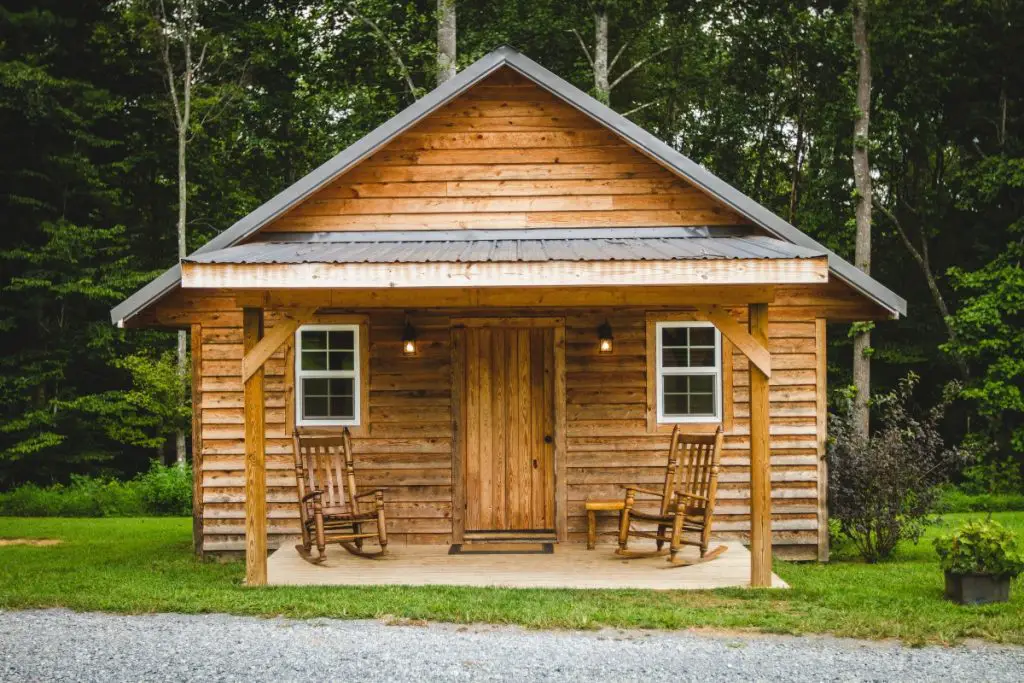Living in a log cabin offers a unique blend of rustic charm and natural beauty. However, maintaining these structures requires specific care and attention. In this article, we explore essential tips for the upkeep and maintenance of your log cabin. We’ll cover practical strategies to ensure your log cabin remains a sturdy and inviting haven for years to come.
Contents
- 1 Log Cabin Basics
- 2 FAQ on Maintaining and Upkeeping Your Log Cabin
- 3 Conclusion
Log Cabin Basics
Living in a log cabin offers a unique experience that blends tradition with a connection to nature. However, understanding the basics of log cabin construction and materials is crucial for effective maintenance. This knowledge helps in preserving the cabin’s structural integrity and aesthetic value.
The Unique Nature of Log Cabins
Log cabins stand out due to their distinct construction style. Built primarily from logs, these structures are known for their sturdy build and rustic appeal. The logs serve both structural and aesthetic purposes, making them fundamental to the cabin’s design. Understanding how these logs interact with environmental factors is key to maintaining a log cabin.
Key Materials in Log Cabin Construction
The type of wood used in a log cabin plays a significant role in its longevity. Commonly used woods include pine, cedar, and spruce, each offering different benefits. For example, cedar is resistant to rot and insects, making it a popular choice. It’s important to know the type of wood your cabin is made of, as this influences maintenance strategies and product choices.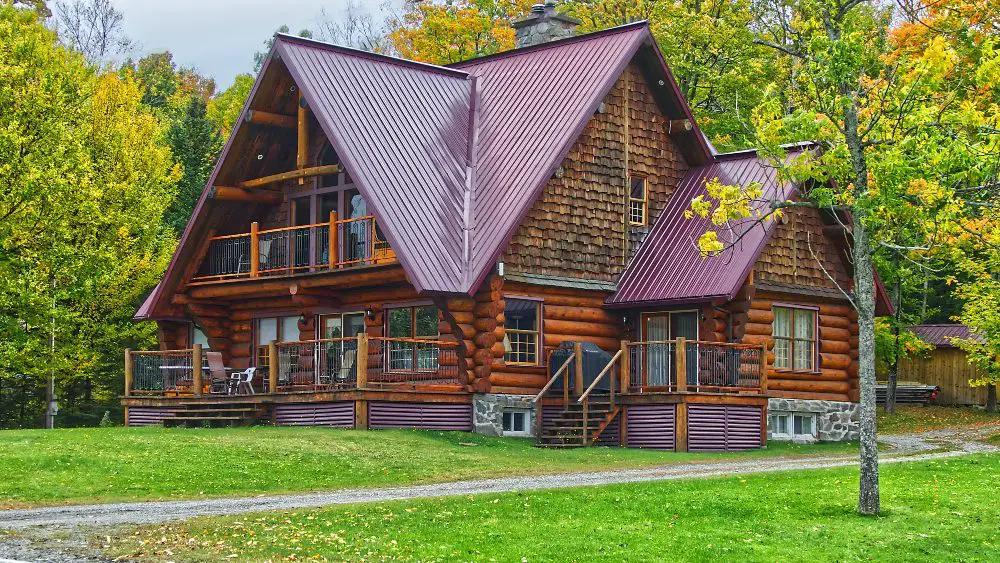
Modern Log Cabins and Energy-Efficiency
An expanding number of individuals are choosing to develop more advanced forms of conventional log cabins, mixing rural straightforwardness with tough style.
Gone are the days of fundamental, single-room cabins warmed by a central wood stove. Instep, modern log cabins regularly epitomize extravagance at its finest. Not as it were that, but present-day log cabins regularly grasp the eco-friendly and feasible mantras that characterize advanced living.
These days, log cabins are outfitted with sky-facing windows and enormous windows in essentially each common range, eventually giving the cabin a part more tasteful excellence, while moreover serving the exceptionally considered work of permitting as much normal light as conceivable.
Besides, numerous log cabin proprietors are picking a completely prepared kitchen over a wood stove. Despite their initial appearances, cutting-edge appliances frequently come with a Vitality Star rating, demonstrating they are planned for vitality proficiency. This Vitality Star rating amplifies HVAC frameworks, water radiators, warm pumps, and other family apparatuses.
Renewable vitality updates such as sun-oriented boards, windmills, and geothermal warming may be introduced for more inaccessible off-grid cabins. By utilizing renewable vitality sources, log cabin proprietors can essentially decrease their dependence on outside vitality sources, taking a toll on reserve funds.
Proprietors of energy-efficient log cabins may qualify for the Residential Energy Efficient Property Credit (REEPC), Nonbusiness Energy Property Credit, as well as state and neighborhood charge motivations. These tax incentives can be claimed when your personal income taxes for the year. It is recommended that you consult with a tax professional before filing your taxes, as the rules and regulations surrounding energy-efficiency tax incentives are always changing.
Log Cabin Maintenance Essentials
Cleaning your log cabin and maintaining that fresh wooden look throughout the year can be a challenge. Below are practical maintenance and care tips for your wooden cabin.
Regular Maintenance Checks
Consistent maintenance is vital for preserving the beauty and integrity of a log cabin. Regular checks help identify potential issues before they become major problems. Here’s how to conduct effective maintenance checks.
Identifying Signs of Infestation
Pests like termites, carpenter ants, and beetles can compromise the structural integrity of a log cabin. Look for signs such as:
- Boreholes: Small, round holes in the wood indicating insect activity.
- Sawdust: Fine wood shavings near the base of logs, a sign of wood-boring insects.
- Unusual Sounds: Soft rustling or clicking noises within the walls may signify the presence of pests.
Checking for Rot
Wood rot, caused by fungi, can weaken logs significantly. Regular inspections can help catch rot early. Pay attention to:
- Soft Spots: Gently probe the wood with a tool. Soft, crumbly areas suggest rot.
- Discoloration: Dark spots or patches on the wood could indicate moisture accumulation and subsequent rot.
- Mold or Mildew: The presence of mold or mildew on the surface of logs is often a precursor to rot.
Ensuring Proper Ventilation
Good air circulation is crucial for keeping the logs dry and preventing rot. Here’s how to ensure proper ventilation:
- Install Adequate Ventilation Systems: Consider adding vents or fans, especially in areas like the attic and basement, to promote airflow.
- Maintain Clear Space Around the Cabin: Keep the area around your cabin clear of vegetation and debris that can block air circulation.
- Check for Obstructions: Regularly inspect vents and airways for blockages, and clear them to maintain continuous air flow.
Regular Cleaning and Maintenance
Keeping your cabin clean can greatly reduce the chances of pest infestation and wood rot.
- Remove Debris and Foliage: Clear leaves, twigs, and other organic materials that accumulate around your cabin. These can trap moisture against the wood, creating a habitat for rot and pests.
- Clean Gutters and Drains: Ensure gutters and drains are free of blockages to prevent water accumulation.
- Inspect and Clean the Cabin Exterior: Wash the exterior of your cabin annually to remove dirt and mildew. This not only keeps the cabin looking good but also reduces the likelihood of wood decay.
Using Chemical Treatments
Chemical treatments can provide an additional layer of protection for your log cabin.
- Select Appropriate Wood Preservatives: Choose preservatives that are specifically designed for log cabins. These will help protect the wood from rot and insects.
- Apply Pest Repellents: Use repellents to ward off insects. Be sure to choose products that are safe for use in log cabins and the environment.
- Routine Application: Regularly apply these treatments according to the manufacturer’s instructions. This will maintain their effectiveness in protecting your cabin.
Seasonal Maintenance Routines for Log Cabins
Maintaining a log cabin requires adapting your approach to the changing seasons. Each season brings its unique set of challenges and maintenance needs.
Spring Maintenance
In spring, the focus is on recovery from winter and preparation for wetter, more humid conditions. This is the time to thoroughly clean your gutters and downspouts to ensure proper drainage during spring rains. Inspect your cabin for water damage, particularly around the foundation, windows, and doors, where melting snow and ice may have left their mark.
Spring is also when you should start preparing for increased humidity, which can affect the wood. Checking and maintaining dehumidifying systems or ensuring good natural ventilation can prevent moisture buildup.
Summer Maintenance
Summer brings warmth and, with it, increases insect activity. Regular inspections during this season are crucial to identify any signs of infestations early. Look for signs of termites, beetles, and other wood-loving pests. This is also a good time to check the sealant and stains on your cabin’s exterior. The sun and heat can cause them to degrade, so reapplying or touching up these protective layers helps protect the wood from UV damage and keeps it in good condition.
Fall Maintenance
Fall is the time to prepare your log cabin for the cold months ahead. Begin by inspecting and servicing your heating systems to ensure they are ready for winter. Check for gaps in the cabin’s caulking and seal any openings to keep the heat in and pests out.
This is also a prime time to do a thorough check of the roof and chimney, ensuring they are in good condition to withstand winter weather. Clearing away any fallen leaves or debris from the cabin’s surroundings can also prevent moisture accumulation and rot.
Winter Maintenance
Winter maintenance is largely about monitoring and responding to snow and ice. Pay close attention to snow accumulation, especially on the roof and around the foundation. Excessive snow weight can cause structural issues, so it may be necessary to safely remove snow from these areas. Additionally, keeping an eye on the interior for signs of drafts or cold spots can help you identify areas where insulation or sealing might need improvement.
Cleaning and Caring for Logs
Maintaining the logs is crucial in preserving the aesthetics and structural integrity of a log cabin. Proper cleaning and care can prevent decay and extend the life of the logs.
Gentle Cleaning
When cleaning the logs, it’s important to use a method that is effective yet gentle. Opt for a mild detergent mixed with water and use a soft-bristled brush for scrubbing. This approach is gentle enough to prevent damage to the wood’s surface.
Avoid using high-pressure washing techniques, as these can be too harsh on the logs, leading to erosion and potential water infiltration into the wood. Gentle cleaning should be done periodically to remove dirt and grime, maintaining the natural look and health of the wood.
Mold and Mildew Removal
In areas with high humidity or moisture, mold, and mildew can be a common problem on log surfaces. To tackle this, use a solution of mild bleach mixed with water. Apply this mixture to the affected areas and gently scrub to remove the mold or mildew.
It’s important to be thorough yet gentle to avoid damaging the wood. After scrubbing, rinse the area thoroughly with water to remove any residual bleach solution. This process not only cleans the surface but also helps prevent the future growth of mold and mildew.
Regular Dusting
Dust and small particles can easily settle into the grooves and textures of log surfaces. Regular dusting is therefore crucial to maintain the wood’s aesthetic appeal. Use a soft cloth or a brush with soft bristles to gently remove dust. This should be done frequently, depending on the location and exposure of your cabin to natural elements.
Dusting not only keeps the logs looking clean but also allows for a closer inspection of the wood’s condition, helping in the early detection of potential issues like cracks or pest infestation.
Products to Avoid in Log Cabin Maintenance
In maintaining a log cabin, it’s not only about what you do but also about what you should not do. Certain products can cause more harm than good to your log cabin. Here’s a closer look at what to avoid.
Harsh Chemicals
It’s crucial to steer clear of strong chemicals when maintaining your log cabin. Products like chlorine bleach or harsh cleaners can strip the natural oils from the wood. This can lead to a host of problems, including dryness, cracks, and increased susceptibility to pests and rot.
These chemicals can also disrupt the wood’s natural balance, leading to premature aging and weakening of the logs. Instead, opt for gentler, wood-friendly cleaning agents that clean effectively without causing damage.
High-Pressure Washers
While high-pressure washers might seem like a quick and efficient way to clean your log cabin, they can be quite detrimental. The intense pressure can erode the wood’s surface, leading to roughness and uneven textures.
This erosion can also create pathways for water to infiltrate the logs, potentially causing internal damage and decay. It’s better to use gentler methods of cleaning to preserve the integrity of the wood.
Oil-Based Treatments
Oil-based treatments are often used on wood surfaces, but they’re not always the best choice for log cabins. These treatments can create a sticky surface that attracts and traps dirt, dust, and other particulates. This not only makes the cabin look unclean but can also lead to a buildup that’s hard to remove.
Additionally, some oil-based products can create an environment that encourages fungal growth, particularly in humid conditions. Instead, look for treatments specifically designed for log cabins, focusing on those that protect without the negative side effects of oil-based products.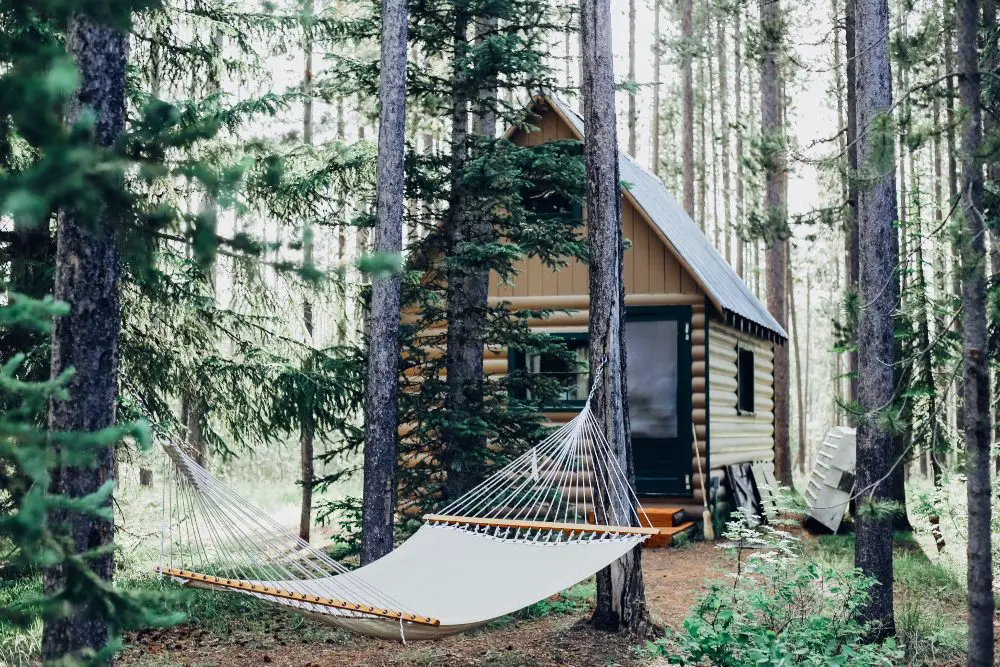
Weatherproofing Your Log Cabin
Effectively weatherproofing your log cabin is essential for its longevity and to maintain its aesthetic appeal. Here’s a detailed approach to each step of the process.
Sealing and Staining Logs
The process of sealing and staining is critical in protecting the wood from various elements. Begin by choosing a high-quality sealant that is specifically designed for log cabins. A good sealant will offer robust protection against moisture and UV rays, which are the primary causes of log degradation. When applying the sealant, ensure thorough coverage, paying extra attention to joins and ends where moisture can easily penetrate.
Staining is equally important as it not only enhances the visual appeal of your cabin but also provides an additional protective layer. Select a stain that complements the wood’s natural tones and is formulated to resist weather-related wear. When applying stain, do it evenly to avoid streaks and ensure consistent protection. Remember, both sealant and stain will degrade over time, so inspect your cabin annually and reapply as necessary, focusing on areas that get the most exposure to sunlight and precipitation.
Addressing Moisture Control
Moisture is one of the biggest threats to a log cabin, so controlling it is a top priority. Start by ensuring that the ground around your cabin slopes away from the foundation to prevent water pooling. Gutters and downspouts should be kept clean and in good repair to effectively channel water away from the cabin. Additionally, consider installing French drains or similar systems if you’re in an area prone to heavy rainfall. Inside the cabin, use dehumidifiers if necessary, especially during the more humid months, to maintain an optimal indoor moisture level.
Insulating Against Cold
Proper insulation is crucial for keeping your log cabin warm and energy-efficient during colder months. Check for drafts around windows, doors, and where the walls meet the roof. Seal any gaps with caulking or weather stripping. Insulating the roof and installing double-glazed windows can also greatly enhance the cabin’s ability to retain heat. If you have a fireplace or wood stove, ensure it’s well-maintained and the chimney is regularly cleaned for maximum heating efficiency.
Protection Against Heat and Sun
In warmer climates or during summer months, protecting your log cabin from excessive heat and sun is essential. UV-protective coatings on windows can significantly reduce sun damage to both the interior and exterior of your cabin.
Installing shades or blinds can also help in controlling the amount of sunlight entering the cabin, thus keeping it cooler. Consider planting trees or shrubs strategically around your cabin to provide natural shade, which can also enhance the overall aesthetic of your property.
Moisture Control
Controlling moisture around your log cabin is a crucial step in weatherproofing. Good drainage is essential to prevent water accumulation, which can lead to wood rot and structural damage. Start by inspecting the landscape around your cabin. Ensure the ground slopes away from the foundation, allowing water to naturally drain.
Adding or maintaining a French drain system can also be beneficial, especially in areas prone to heavy rainfall. Gutters and downspouts play a critical role in moisture control. They should be regularly cleaned and inspected to ensure they are functioning correctly. These systems direct rainwater away from the cabin, preventing water from pooling around the base. Consider extending your downspouts if necessary to further direct water away from the structure.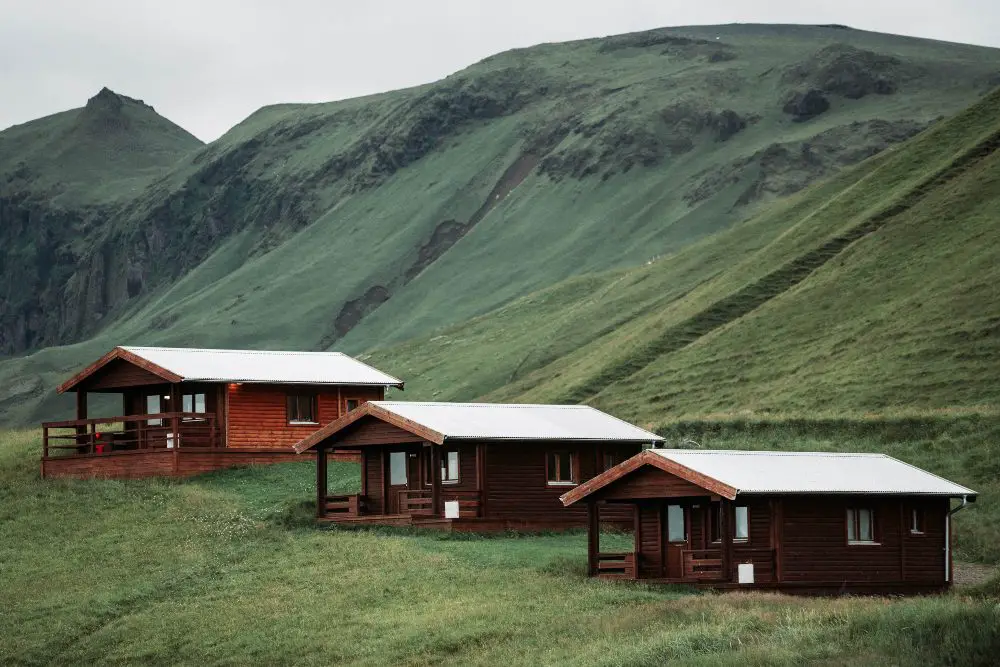
Insulation Against Cold
Proper insulation is essential for keeping your log cabin warm and comfortable during the colder months. Effective insulation not only retains heat but also reduces energy costs. Start by inspecting your cabin for drafts, particularly around windows, doors, and where the roof meets the walls. Use caulking or weather stripping to seal any gaps.
Insulating materials can be added to the walls and roof to bolster warmth retention. In older cabins, consider updating insulation to more modern, efficient materials. Double-glazed windows can also make a significant difference in maintaining heat inside the cabin. Additionally, ensure that the fireplace or wood stove, if present, is well-maintained and vented properly, as these can be excellent sources of heat in the winter.
Heat and Sun Protection
In warmer climates, protecting your log cabin from the heat and sun is crucial to preserve both its interior and exterior. Prolonged exposure to sunlight can fade and damage wood and excess heat can make the cabin uncomfortably warm. UV-protective window coatings are an effective solution.
These coatings can significantly reduce the amount of UV light entering the cabin, thereby protecting interior furnishings and reducing the heat build-up inside. Installing shades, blinds, or heavy curtains can provide additional protection and help control the interior temperature. Consider the strategic placement of trees or tall shrubs around your cabin.
They not only provide natural shade but also add to the cabin’s rustic aesthetic. Remember, maintaining a balance between sun protection and enjoying natural light is key in warmer climates.
Interior Maintenance of Log Cabins
Maintaining the interior of a log cabin is just as important as caring for its exterior. The inside of your cabin requires specific attention to preserve the wood and ensure a comfortable living space. Here’s how to effectively maintain the interior of your log cabin.
Preserving Interior Wood Surfaces
The wood inside your cabin is exposed to different stresses than the exterior. To keep it in good condition, regular cleaning and treatment are necessary.
- Cleaning: Use a soft cloth or brush to remove dust and cobwebs. For deeper cleaning, a mild wood cleaner can be used. Avoid harsh chemicals that can strip the wood of its natural oils.
- Treating the Wood: Depending on the type of wood and the desired aesthetic, you may use a variety of treatments. Linseed or tung oil can enhance the natural beauty of the wood while providing protection. For a more polished look, varnishes or sealants can be applied. However, it’s important to use products specifically designed for indoor use to maintain good air quality.
- Avoiding Damage: Place coasters under plant pots to prevent water damage, and use felt pads under furniture to avoid scratches.
Humidity Control and Ventilation
Balancing the humidity inside a log cabin is crucial for both comfort and the preservation of the wood.
- Monitor Humidity Levels: Too much humidity can lead to mold and mildew, while too little can cause the wood to dry out and crack. Use a hygrometer to monitor the indoor humidity levels.
- Use Dehumidifiers or Humidifiers: Depending on the climate and season, you may need to use a dehumidifier to reduce moisture or a humidifier to add moisture to the air.
- Ensure Good Ventilation: Regularly open windows and doors to allow air circulation, especially in areas like kitchens and bathrooms where moisture can accumulate.
Energy Efficiency in Log Cabins
Improving the energy efficiency of a log cabin is crucial for both environmental sustainability and cost-effectiveness. Here are key strategies to enhance the energy efficiency of your log cabin.
Insulation and Energy-Saving Tips
Proper insulation is a cornerstone of energy efficiency in log cabins. It helps maintain a comfortable interior climate while reducing heating and cooling costs.
- Upgrade Insulation: Check the insulation in walls, ceilings, and floors. If necessary, upgrade to higher-quality materials that provide better thermal resistance.
- Seal Gaps and Cracks: Small gaps and cracks can significantly impact energy efficiency. Use caulk or weather stripping to seal any openings around windows, doors, and where the walls meet the roof.
- Energy-Efficient Windows and Doors: Consider installing double-glazed windows and insulated doors. These can drastically reduce heat loss in winter and heat gain in summer.
- Use Energy-Efficient Appliances: Opt for appliances with high energy-efficiency ratings. This includes heating and cooling systems, refrigerators, and lighting.
Sustainable Practices for Log Cabin Living
Sustainable living practices can greatly enhance the energy efficiency of your log cabin.
- Solar Power: If feasible, install solar panels. Solar energy can provide a significant portion of your cabin’s electricity needs, reducing reliance on non-renewable energy sources.
- Smart Thermostats: Use smart thermostats to regulate temperature more efficiently. These devices can adjust your schedule and adjust heating or cooling accordingly.
- LED Lighting: Replace traditional bulbs with LED lights, which use less energy and last longer.
- Water Conservation: Implement water-saving measures like low-flow showerheads and faucets, and consider rainwater harvesting for non-potable uses.
Repair and Restoration
Maintaining the structural integrity and aesthetic appeal of a log cabin often involves timely repairs and restoration. Addressing issues promptly can prevent small problems from becoming major, costly ones. Here’s how to approach the repair and restoration of your log cabin.
Structural Issues
Significant structural issues are a clear sign that professional intervention is needed. If you observe major cracks in the logs, sagging beams, or foundation problems, these are not just cosmetic issues but can threaten the entire structure’s integrity.
Such problems require a thorough assessment and repair by a professional who has experience with log cabin structures. They can determine the cause, the extent of the damage, and the most effective repair strategy. Attempting DIY repairs on serious structural issues can lead to further damage and even pose safety risks.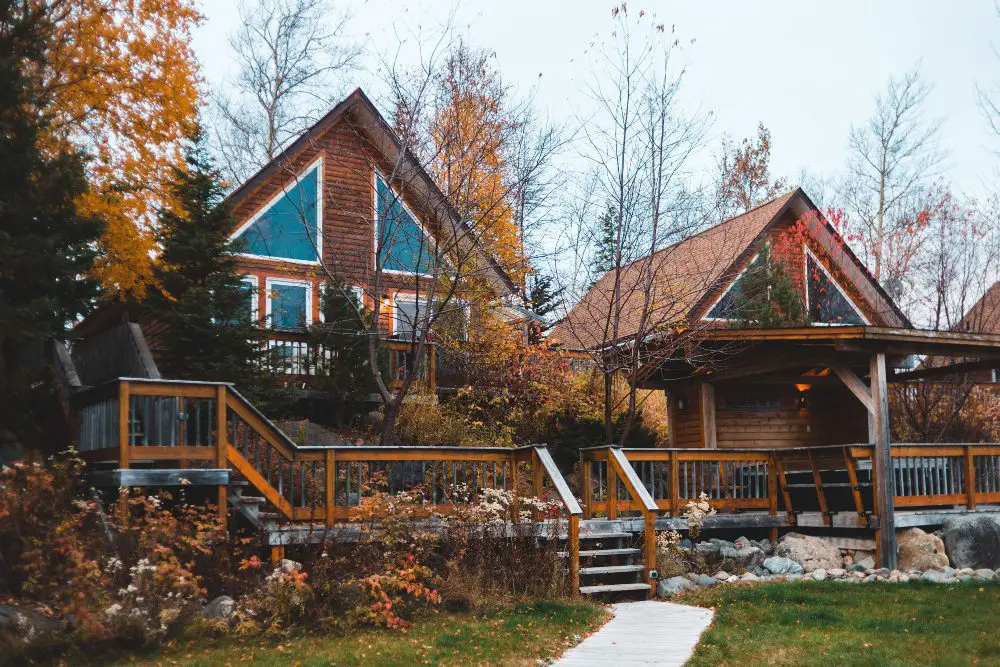
Pest Damage
Log cabins are susceptible to pest infestations, particularly from termites and carpenter ants, which can cause extensive damage. If you notice signs of significant pest damage, such as extensive boreholes, weakened wood, or large areas of decay, professional pest control and repair services are necessary.
Professionals have the tools, treatments, and expertise to effectively eradicate pests and repair the damage they’ve caused, ensuring the cabin’s long-term health and structural stability.
Mold and Rot
While small patches of mold can often be handled with home remedies, widespread mold or wood rot requires professional attention. These issues can be symptoms of deeper problems like persistent moisture, poor ventilation, or structural defects.
Experts can assess the severity of the mold or rot, identify the underlying cause, and recommend solutions. They can also safely remove infected materials and perform necessary repairs or replacements, preventing potential health hazards and preserving the cabin’s structural integrity.
Filling Cracks and Gaps
Small cracks and gaps in the wood are common in log cabins but can be effectively managed with the right approach.
- Choosing the Right Material: Select a wood filler or caulk that is specifically designed for log cabins. These products are formulated to be compatible with the wood and to withstand the cabin’s specific environmental conditions.
- Application Process: Clean the area around the crack or gap thoroughly before application. Apply the filler or caulk carefully, ensuring it penetrates the crack or gap. Smooth it out to ensure a flush finish with the wood surface. This not only improves the aesthetic appearance but also prevents moisture and pests from entering through these small openings.
Refinishing Surfaces
Over time, wood surfaces inside and outside the cabin can lose their luster and may need refinishing.
- Sanding the Wood: Begin by sanding down the wood surfaces. This removes the old finish, smoothens the surface, and prepares it for the new finish. Use sandpaper suitable for the wood type and be gentle to avoid causing scratches.
- Applying Stain or Sealant: Choose a stain or sealant that matches your cabin’s style and provides adequate protection. Apply it evenly with a brush or a rag, following the wood’s grain. This not only rejuvenates the wood’s appearance but also adds a protective layer against environmental elements.
Replacing Damaged Logs
Replacing damaged logs is a more complex task and requires a realistic assessment of your DIY skills.
- Assessing the Damage: Identify the logs that are damaged beyond repair. Check for extensive rot, deep cracks, or structural weakness.
- Removal and Replacement: Carefully remove the damaged log without disturbing the surrounding structure. Measure and cut the new log to fit, and securely place it in position. Ensure that it aligns correctly with the existing structure. While some handypersons might tackle this task, don’t hesitate to seek professional help if the task seems beyond your skill level.
FAQ on Maintaining and Upkeeping Your Log Cabin
How often should I inspect my log cabin for maintenance needs?
It’s recommended to inspect your log cabin at least once a year. However, certain aspects like checking for pests or clearing gutters may need more frequent attention, especially after severe weather conditions.
Can I use regular household cleaners for the interior wood surfaces of my log cabin?
It’s best to avoid harsh household cleaners as they can strip the natural oils from the wood. Use mild wood cleaners specifically designed for log cabin interiors to prevent damage to the wood.
Is it necessary to re-stain and re-seal the exterior of my log cabin? If so, how often?
It is necessary to maintain the stain and sealant on the exterior of your log cabin. Typically, re-staining and re-sealing should be done every 3-5 years, but this can vary based on the climate and the wood’s exposure to elements.
What are the signs of pest infestation in a log cabin?
Signs of pest infestation include visible boreholes in the wood, sawdust piles, weakened or hollow-sounding wood, and actual sightings of pests like termites or beetles.
How can I improve the energy efficiency of my log cabin?
Improving energy efficiency can be achieved through proper insulation, sealing gaps and cracks, using energy-efficient windows and doors, installing energy-efficient appliances, and considering renewable energy sources like solar panels.
What should I do if I find mold or rot in my log cabin?
Small areas of mold can be cleaned using a mild bleach solution. However, for extensive mold or wood rot, it’s advisable to seek professional help to assess and treat the problem effectively.
Can I replace damaged logs myself?
Replacing damaged logs can be complex and might require professional skills, especially if the damage affects the cabin’s structure. If you have experience in carpentry and log work, you might tackle minor replacements; otherwise, it’s safer to hire a professional.
Is it necessary to have a professional do all the maintenance work on my log cabin?
Not necessarily. Many maintenance tasks can be done as DIY projects, such as regular cleaning, minor repairs, and some refinishing work. However, for complex issues like structural repairs, professional expertise is recommended.
Conclusion
Maintaining a log cabin requires dedication and an understanding of its unique needs. Regular checks, proper cleaning, and timely repairs are essential in preserving the cabin’s beauty and structural integrity.

